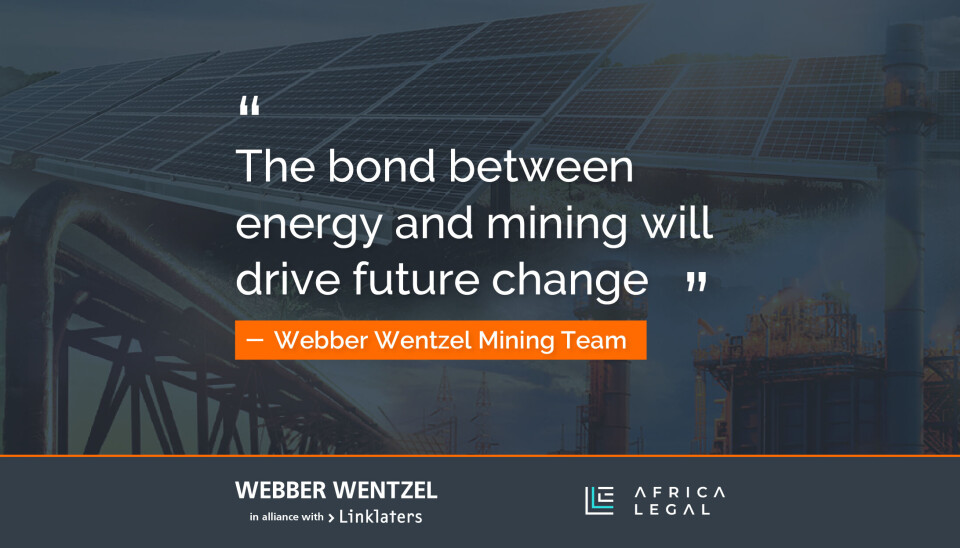Copyright : Re-publication of this article is authorised only in the following circumstances; the writer and Africa Legal are both recognised as the author and the website address www.africa-legal.com and original article link are back linked. Re-publication without both must be preauthorised by contacting editor@africa-legal.com
Inseparable: the bond between energy and mining will drive future change

Webber Wentzel is a leading legal adviser for the mining sector in Sub-Saharan Africa. Ahead of Mining Indaba, their team discuss how the mining industry will play a key role in achieving energy transition
Fossil fuels, such as coal and oil, and other forms of energy production, are primarily responsible for driving the advancement of modern civilisation and have provided the base power necessary to develop new forms of energy production.
In 1990, out of 95,533 terawatt-hours (TWh) of global energy consumed, 39.3% came from oil, 27.1% from coal, 20.3% from gas, 6.6% from hydropower, and 5.9% from nuclear, accounting for 99.2% of total global energy consumption. By 2023, global energy consumption had almost doubled to 172,119 TWh, with oil’s contribution declining to 31.7%, coal steady at 26.4%, gas rising to 23.2%, and nuclear and hydropower combined dropping to 10.3%.
The coal and oil industries continue to provide the world with a reliable source of power, with the mining sector part of that energy supply chain. Yet, from 0.8% in 1990, wind, solar, biofuels and other renewables represented 8.1% of global energy consumption in 2023, an increase of 913%. Coal and the mining sector that supports it remain crucial to global energy production, but the energy transition is firmly underway at scale.
This transition is due to several factors:
● Shift away from fossil fuels to reduce the impact of global warming and climate change.
● New governance frameworks such as ESG becoming entrenched in the energy sector and those adjacent to it, which has also impacted how new energy projects are financed.
● Declining cost of renewable power and its inputs.
● Increased efficiency of renewable power sources and battery technology.
The indelible growth of the renewable energy sector has led to the increased use and reliance upon the key rare metals that are driving the energy transition, including copper, nickel, manganese, cobalt, lithium and zinc. Without them, off and onshore wind energy would not be possible, nor solar energy and even nuclear energy. The electric vehicle would cease to exist.
Global renewable energy use is only expected to expand exponentially in the coming years, which makes the mining sector a “victory” condition if the energy transition is to succeed.
The mining industry is set to meet the world’s need for rare earth metals (and more)
In the next 30 years, the mining sector will need to extract more minerals from the earth than humanity has mined in the previous 70,000 years. This increased demand for rare earth metals is creating supply pressures within the industry. The International Energy Agency in 2024 warned of a looming copper shortage that will significantly affect the energy transition as discussed above.
It predicted that by 2030, the world’s existing copper mines and projects currently under development will only meet 80% of global project demands, a significant problem with copper mines taking on average 23 years to open.
Furthermore, as the world transitions away from fossil fuels, that does not mean the coal, oil and gas sectors will cease operating. It would be impossible to meet the globe’s energy needs today without coal, oil, and gas. Between 2015 and 2023, 343 new coal mines were opened, including 12 in South Africa. Five of the world’s largest fossil firms were projected to be spending USD 15 million an hour, every hour, until 2030 to produce more oil and gas.
In the coming years, the relationship between the mining and energy sectors will only deepen, with the diversification of the mining sector a consequence of this close relationship.
Mining companies are becoming energy companies
Global hunger for rare earth metals and the mining industry’s proximity to the energy sector have led global energy companies to increasingly diversify their revenue streams where possible. Political events have also led some companies to adopt solar power to support their operations.
In South Africa, by 2022, five of the country’s largest mining companies were producing a combined 355 megawatts of solar power to circumvent the loadshedding (rolling blackout) crisis that had gripped the country. The crisis is now easing with these companies poised to sell excess power back into the market.
China Shenhua Energy is the largest state-owned coal miner in the world. The company is vertically integrated, selling and refining coal, using it to produce power and also operates an integrated coal transportation network, in addition to transporting other commodities.
Seriti Green, a subsidiary of South African mining company Seriti Resources, launched a USD 1.3 billion wind farm in Mpumalanga province in July 2024, with 900 megawatts of wind energy to be constructed over three years. The first phase of the project will supply Seriti Resources with 75% of its coal mine power needs.
The future of global energy production is renewable resources. The renewable energy sector may hold the greatest space in the public imagination on the subject of future energy supply, but it is the mining industry on which the energy transition will be achieved.
New technological developments will prove crucial to the evolution underway as the mining industry expands its exploration efforts, which if assessed holistically, is the sector’s contribution to the modern world coming full circle.
Webber Wentzel’s team of leading mining experts is attending the 2025 Mining Indaba in Cape Town. You can find more information on Indaba, here.
